Curcumin and epithelial-mesenchymal transition in breast cancer cells transformed by low doses of radiation and estrogen
- Authors:
- Marcela Gallardo
- Gloria M. Calaf
-
Affiliations: Instituto de Alta Investigación, Universidad de Tarapacá, Arica 8097877, Chile - Published online on: April 7, 2016 https://doi.org/10.3892/ijo.2016.3477
- Pages: 2534-2542
This article is mentioned in:
Abstract
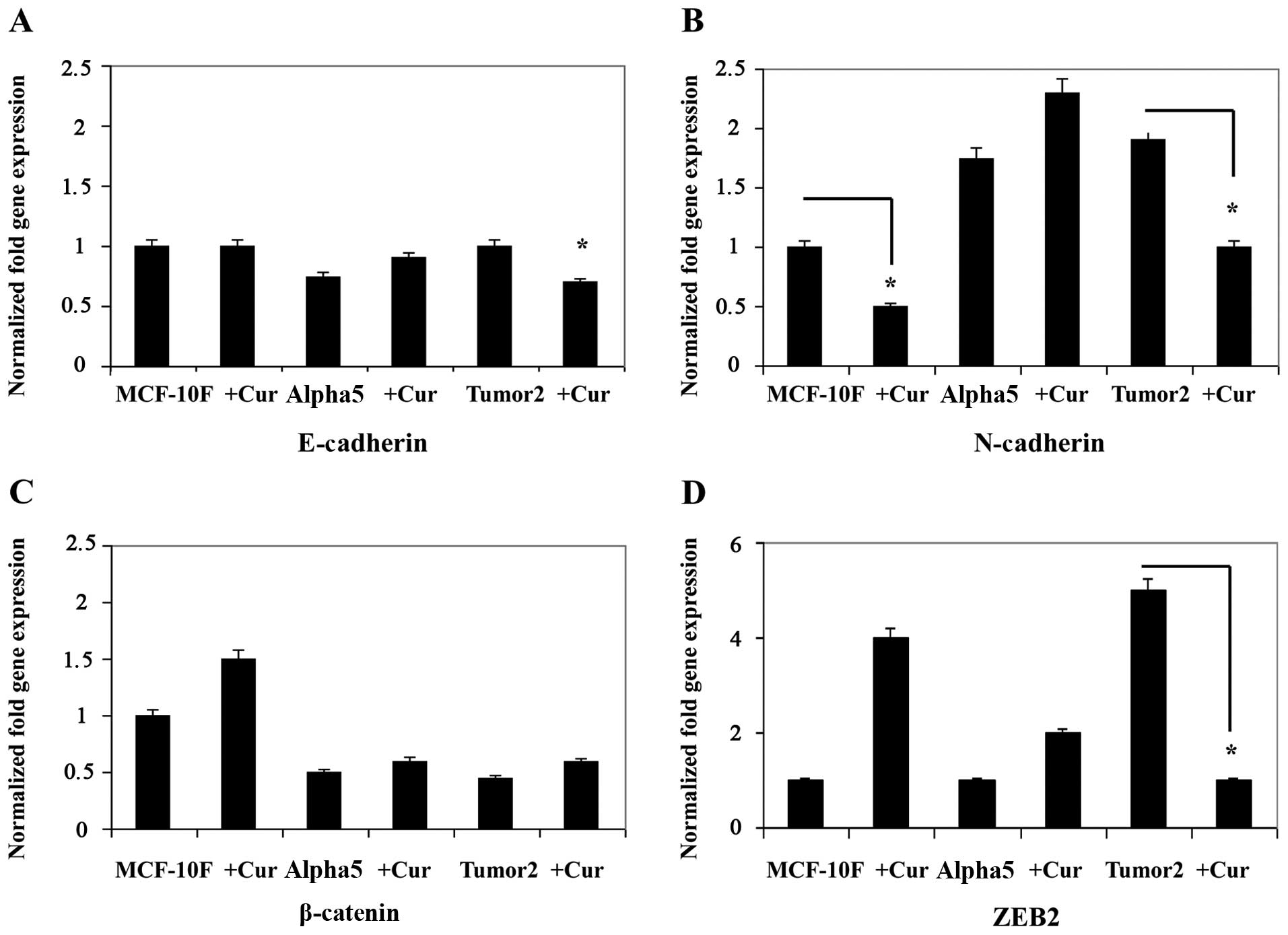 |
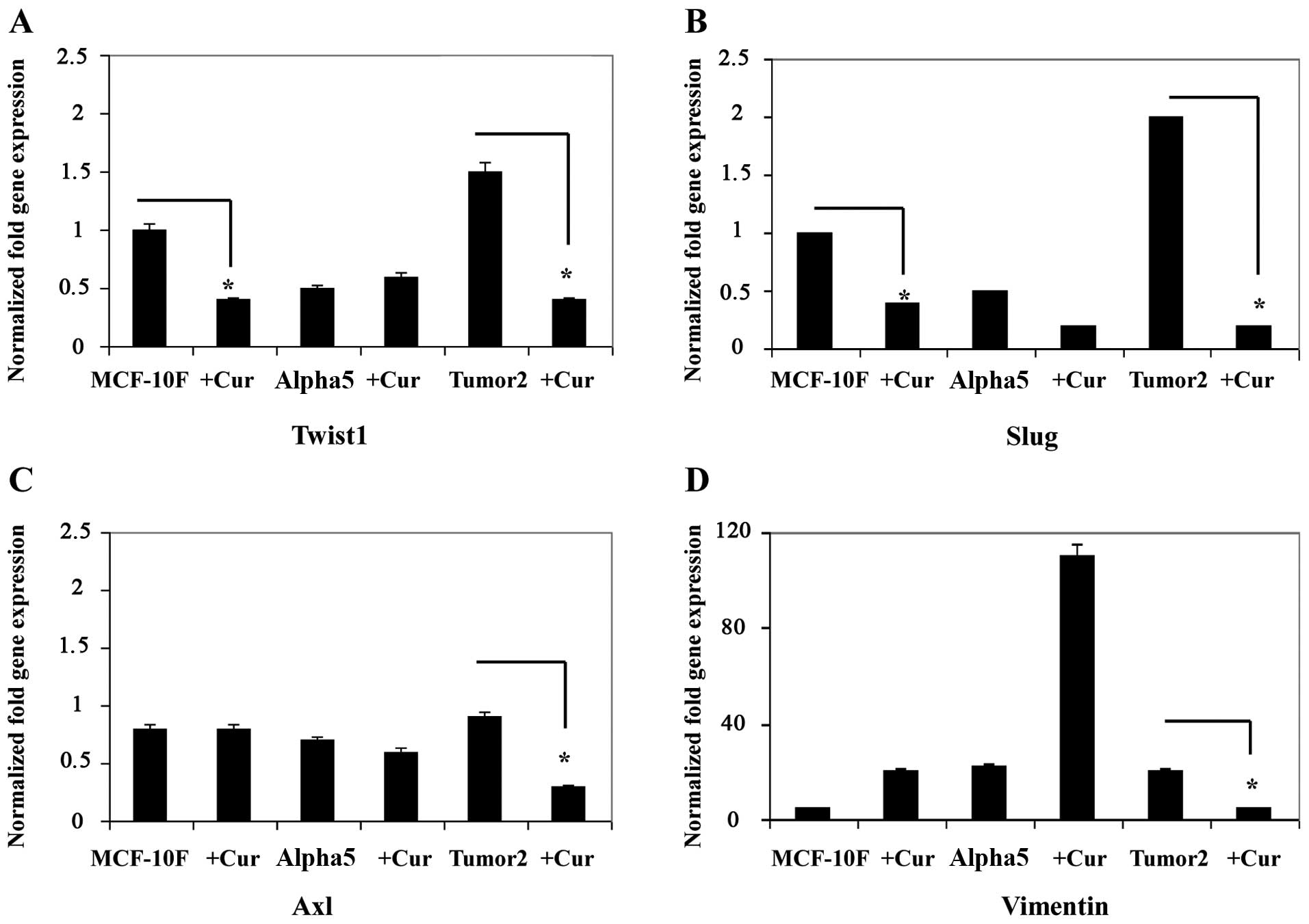 |
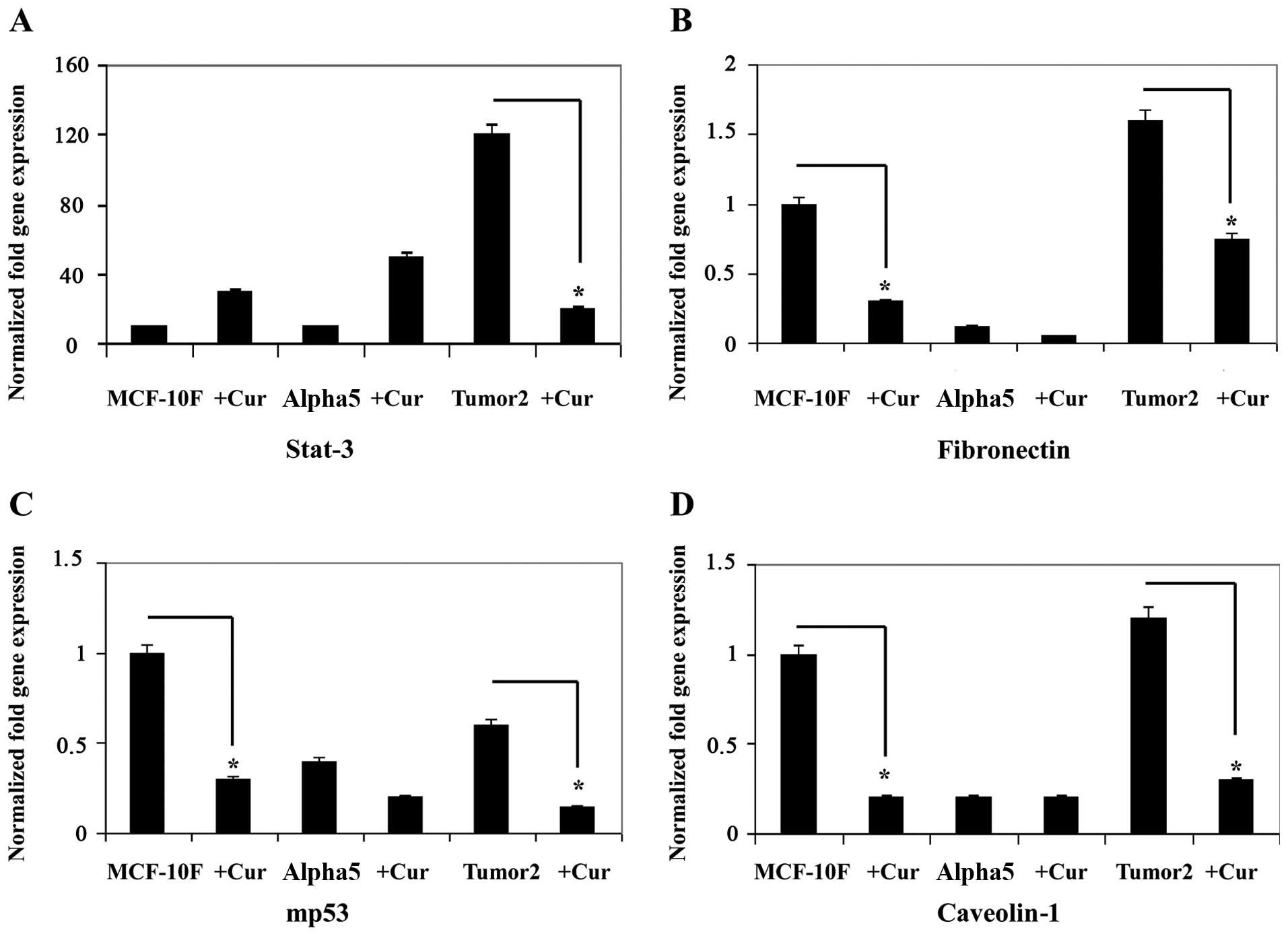 |
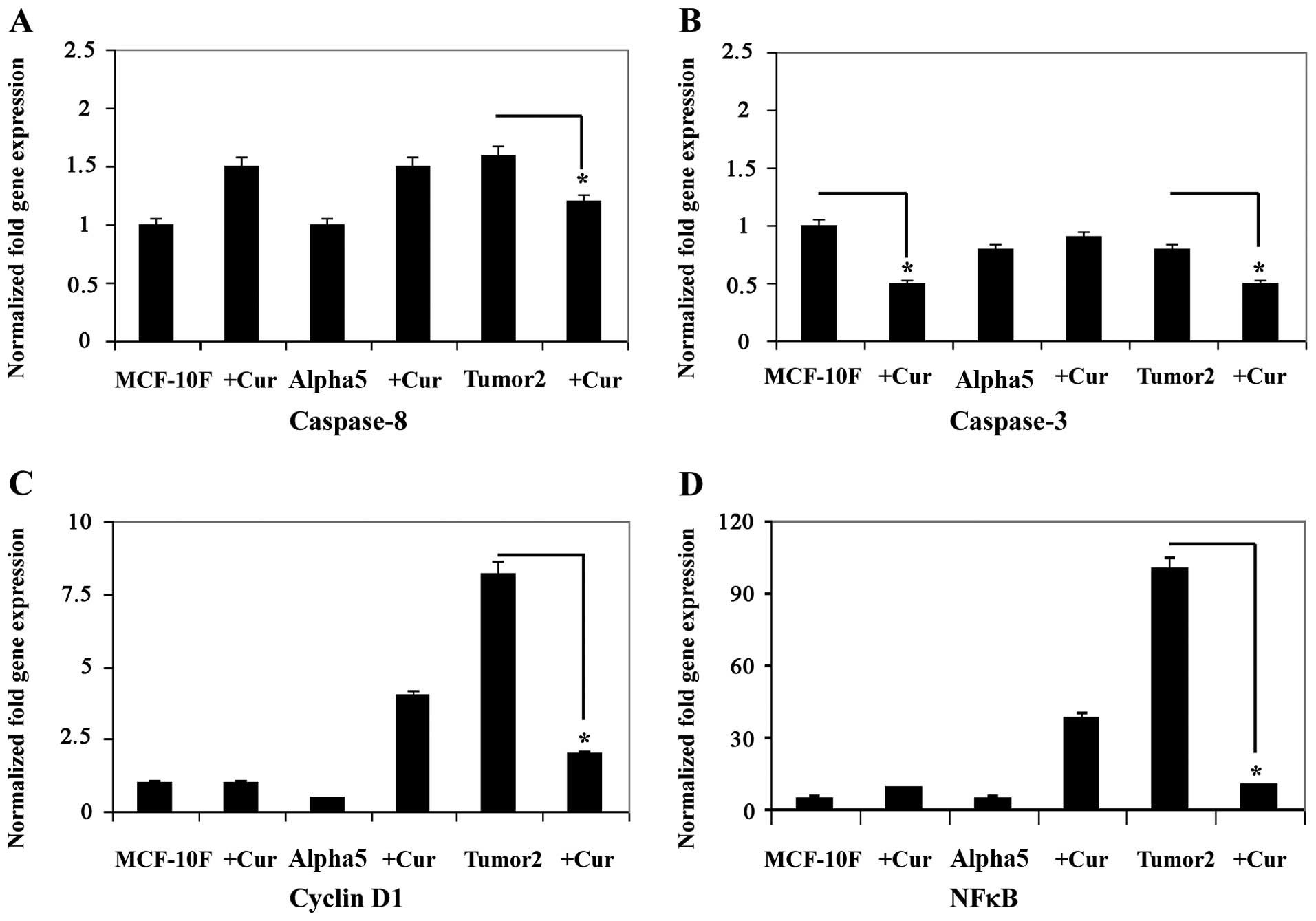 |
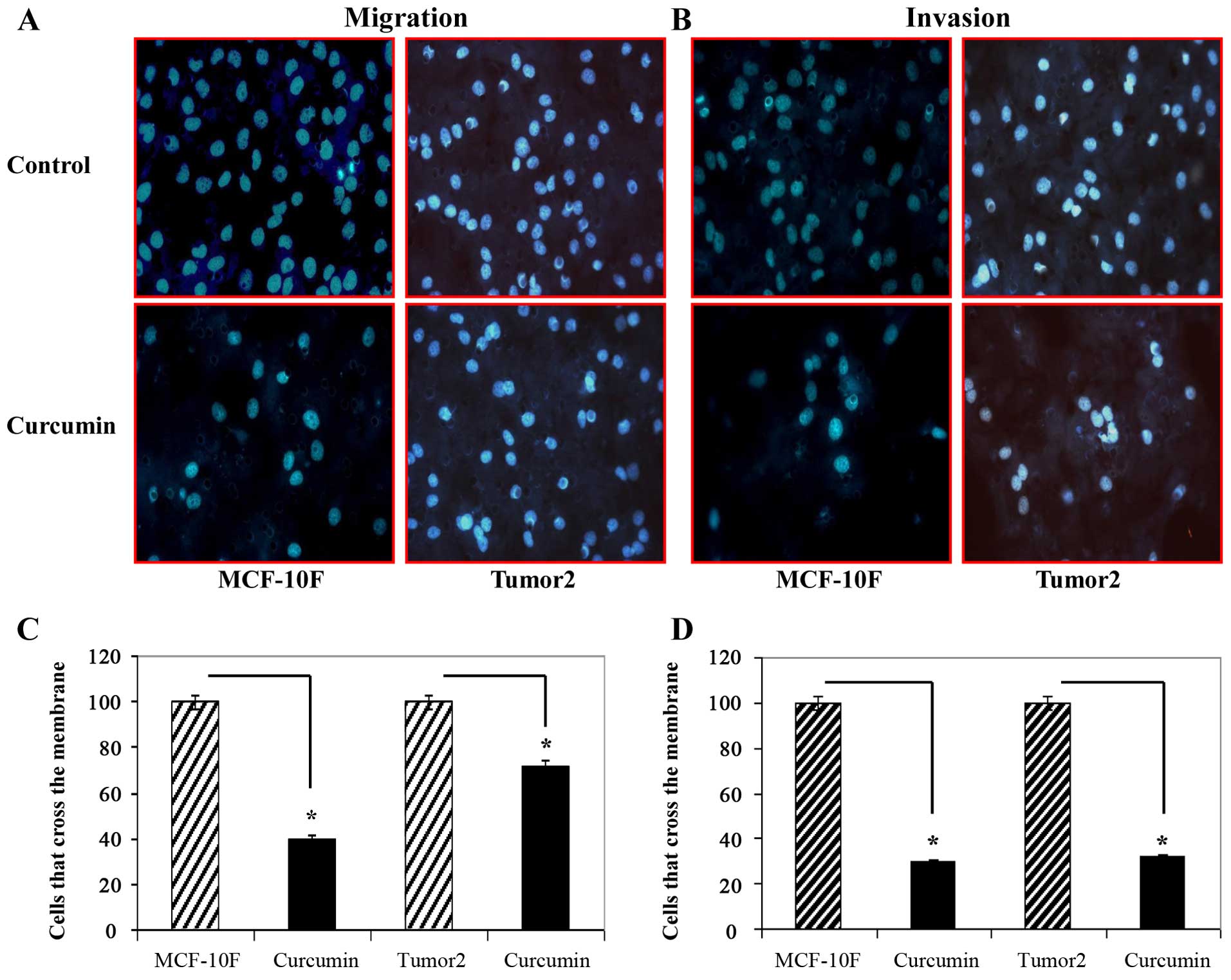 |
|
Kelloff GJ, Crowell JA, Steele VE, Lubet RA, Malone WA, Boone CW, Kopelovich L, Hawk ET, Lieberman R, Lawrence JA, et al: Progress in cancer chemoprevention: Development of diet-derived chemopreventive agents. J Nutr. 130(Suppl): 467S–471S. 2000.PubMed/NCBI | |
|
Khar A, Ali AM, Pardhasaradhi BV, Varalakshmi CH, Anjum R and Kumari AL: Induction of stress response renders human tumor cell lines resistant to curcumin-mediated apoptosis: Role of reactive oxygen intermediates. Cell Stress Chaperones. 6:368–376. 2001. View Article : Google Scholar | |
|
Ramachandran C, Rodriguez S, Ramachandran R, Raveendran Nair PK, Fonseca H, Khatib Z, Escalon E and Melnick SJ: Expression profiles of apoptotic genes induced by curcumin in human breast cancer and mammary epithelial cell lines. Anticancer Res. 25:3293–3302. 2005.PubMed/NCBI | |
|
Cowin P and Welch DR: Breast cancer progression: Controversies and consensus in the molecular mechanisms of metastasis and EMT. J Mammary Gland Biol Neoplasia. 12:99–102. 2007. View Article : Google Scholar | |
|
Moreno-Bueno G, Portillo F and Cano A: Transcriptional regulation of cell polarity in EMT and cancer. Oncogene. 27:6958–6969. 2008. View Article : Google Scholar : PubMed/NCBI | |
|
Yap AS, Brieher WM, Pruschy M and Gumbiner BM: Lateral clustering of the adhesive ectodomain: A fundamental determinant of cadherin function. Curr Biol. 7:308–315. 1997. View Article : Google Scholar : PubMed/NCBI | |
|
Carneiro P, Figueiredo J, Bordeira-Carriço R, Fernandes MS, Carvalho J, Oliveira C and Seruca R: Therapeutic targets associated to E-cadherin dysfunction in gastric cancer. Expert Opin Ther Targets. 17:1187–1201. 2013. View Article : Google Scholar : PubMed/NCBI | |
|
Onder TT, Gupta PB, Mani SA, Yang J, Lander ES and Weinberg RA: Loss of E-cadherin promotes metastasis via multiple downstream transcriptional pathways. Cancer Res. 68:3645–3654. 2008. View Article : Google Scholar : PubMed/NCBI | |
|
Pal S, Ganguly KK and Chatterjee A: Extracellular matrix protein fibronectin induces matrix metalloproteinases in human prostate adenocarcinoma cells PC-3. Cell Commun Adhes. 20:105–114. 2013. View Article : Google Scholar : PubMed/NCBI | |
|
Wang H, Zhu Y, Zhao M, Wu C, Zhang P, Tang L, Zhang H, Chen X, Yang Y and Liu G: miRNA-29c suppresses lung cancer cell adhesion to extracellular matrix and metastasis by targeting integrin β1 and matrix metalloproteinase2 (MMP2). PLoS One. 8:e701922013. View Article : Google Scholar | |
|
Hulit J, Suyama K, Chung S, Keren R, Agiostratidou G, Shan W, Dong X, Williams TM, Lisanti MP, Knudsen K, et al: N-cadherin signaling potentiates mammary tumor metastasis via enhanced extracellular signal-regulated kinase activation. Cancer Res. 67:3106–3116. 2007. View Article : Google Scholar : PubMed/NCBI | |
|
Mandal A, Bhatia D and Bishayee A: Simultaneous disruption of estrogen receptor and Wnt/β-catenin signaling is involved in methyl amooranin-mediated chemoprevention of mammary gland carcinogenesis in rats. Mol Cell Biochem. 384:239–250. 2013. View Article : Google Scholar : PubMed/NCBI | |
|
Nichols SA, Roberts BW, Richter DJ, Fairclough SR and King N: Origin of metazoan cadherin diversity and the antiquity of the classical cadherin/β-catenin complex. Proc Natl Acad Sci USA. 109:13046–13051. 2012. View Article : Google Scholar | |
|
Verschueren K, Remacle JE, Collart C, Kraft H, Baker BS, Tylzanowski P, Nelles L, Wuytens G, Su MT, Bodmer R, et al: SIP1, a novel zinc finger/homeodomain repressor, interacts with Smad proteins and binds to 5′-CACCT sequences in candidate target genes. J Biol Chem. 274:20489–20498. 1999. View Article : Google Scholar : PubMed/NCBI | |
|
Katoh M and Katoh M: Integrative genomic analyses of ZEB2: Transcriptional regulation of ZEB2 based on SMADs, ETS1, HIF1α, POU/OCT, and NF-κB. Int J Oncol. 34:1737–1742. 2009. View Article : Google Scholar : PubMed/NCBI | |
|
Nam EH, Lee Y, Park YK, Lee JW and Kim S: ZEB2 upregulates integrin α5 expression through cooperation with Sp1 to induce invasion during epithelial-mesenchymal transition of human cancer cells. Carcinogenesis. 33:563–571. 2012. View Article : Google Scholar : PubMed/NCBI | |
|
Zhao C, Qiao Y, Jonsson P, Wang J, Xu L, Rouhi P, Sinha I, Cao Y, Williams C and Dahlman-Wright K: Genome-wide profiling of AP-1-regulated transcription provides insights into the invasiveness of triple-negative breast cancer. Cancer Res. 74:3983–3994. 2014. View Article : Google Scholar : PubMed/NCBI | |
|
Yang J, Mani SA, Donaher JL, Ramaswamy S, Itzykson RA, Come C, Savagner P, Gitelman I, Richardson A and Weinberg RA: Twist, a master regulator of morphogenesis, plays an essential role in tumor metastasis. Cell. 117:927–939. 2004. View Article : Google Scholar : PubMed/NCBI | |
|
Casas E, Kim J, Bendesky A, Ohno-Machado L, Wolfe CJ and Yang J: Snail2 is an essential mediator of Twist1-induced epithelial mesenchymal transition and metastasis. Cancer Res. 71:245–254. 2011. View Article : Google Scholar : PubMed/NCBI | |
|
Eckert MA, Lwin TM, Chang AT, Kim J, Danis E, Ohno-Machado L and Yang J: Twist1-induced invadopodia formation promotes tumor metastasis. Cancer Cell. 19:372–386. 2011. View Article : Google Scholar : PubMed/NCBI | |
|
Nieto MA: The snail superfamily of zinc-finger transcription factors. Nat Rev Mol Cell Biol. 3:155–166. 2002. View Article : Google Scholar : PubMed/NCBI | |
|
Barrallo-Gimeno A and Nieto MA: The Snail genes as inducers of cell movement and survival: Implications in development and cancer. Development. 132:3151–3161. 2005. View Article : Google Scholar : PubMed/NCBI | |
|
Hemavathy K, Guru SC, Harris J, Chen JD and Ip YT: Human Slug is a repressor that localizes to sites of active transcription. Mol Cell Biol. 20:5087–5095. 2000. View Article : Google Scholar : PubMed/NCBI | |
|
Wu WS, Heinrichs S, Xu D, Garrison SP, Zambetti GP, Adams JM and Look AT: Slug antagonizes p53-mediated apoptosis of hematopoietic progenitors by repressing puma. Cell. 123:641–653. 2005. View Article : Google Scholar : PubMed/NCBI | |
|
O'Bryan JP, Frye RA, Cogswell PC, Neubauer A, Kitch B, Prokop C, Espinosa R III, Le Beau MM, Earp HS and Liu ET: axl, a transforming gene isolated from primary human myeloid leukemia cells, encodes a novel receptor tyrosine kinase. Mol Cell Biol. 11:5016–5031. 1991. View Article : Google Scholar : PubMed/NCBI | |
|
Bose R, Molina H, Patterson AS, Bitok JK, Periaswamy B, Bader JS, Pandey A and Cole PA: Phosphoproteomic analysis of Her2/neu signaling and inhibition. Proc Natl Acad Sci USA. 103:9773–9778. 2006. View Article : Google Scholar : PubMed/NCBI | |
|
Hafizi S and Dahlbäck B: Gas6 and protein S. Vitamin K-dependent ligands for the Axl receptor tyrosine kinase subfamily. FEBS J. 273:5231–5244. 2006. View Article : Google Scholar : PubMed/NCBI | |
|
Duprey P and Paulin D: What can be learned from intermediate filament gene regulation in the mouse embryo. Int J Dev Biol. 39:443–457. 1995.PubMed/NCBI | |
|
Stewart M: Intermediate filament structure and assembly. Curr Opin Cell Biol. 5:3–11. 1993. View Article : Google Scholar : PubMed/NCBI | |
|
Takeda K and Akira S: STAT family of transcription factors in cytokine-mediated biological responses. Cytokine Growth Factor Rev. 11:199–207. 2000. View Article : Google Scholar : PubMed/NCBI | |
|
Manabe R, Oh-e N and Sekiguchi K: Alternatively spliced EDA segment regulates fibronectin-dependent cell cycle progression and mitogenic signal transduction. J Biol Chem. 274:5919–5924. 1999. View Article : Google Scholar : PubMed/NCBI | |
|
Ohnishi T, Hiraga S, Izumoto S, Matsumura H, Kanemura Y, Arita N and Hayakawa T: Role of fibronectin-stimulated tumor cell migration in glioma invasion in vivo: Clinical significance of fibronectin and fibronectin receptor expressed in human glioma tissues. Clin Exp Metastasis. 16:729–741. 1998. View Article : Google Scholar | |
|
Sakai T, Johnson KJ, Murozono M, Sakai K, Magnuson MA, Wieloch T, Cronberg T, Isshiki A, Erickson HP and Fässler R: Plasma fibronectin supports neuronal survival and reduces brain injury following transient focal cerebral ischemia but is not essential for skin-wound healing and hemostasis. Nat Med. 7:324–330. 2001. View Article : Google Scholar : PubMed/NCBI | |
|
Moursi AM, Damsky CH, Lull J, Zimmerman D, Doty SB, Aota S and Globus RK: Fibronectin regulates calvarial osteoblast differentiation. J Cell Sci. 109:1369–1380. 1996.PubMed/NCBI | |
|
Johansson S, Svineng G, Wennerberg K, Armulik A and Lohikangas L: Fibronectin-integrin interactions. Front Biosci. 2:d126–d146. 1997. View Article : Google Scholar : PubMed/NCBI | |
|
Sottile J and Hocking DC: Fibronectin polymerization regulates the composition and stability of extracellular matrix fibrils and cell-matrix adhesions. Mol Biol Cell. 13:3546–3559. 2002. View Article : Google Scholar : PubMed/NCBI | |
|
Goerges AL and Nugent MA: pH regulates vascular endothelial growth factor binding to fibronectin: A mechanism for control of extracellular matrix storage and release. J Biol Chem. 279:2307–2315. 2004. View Article : Google Scholar | |
|
Rao B, Lain S and Thompson AM: p53-Based cyclotherapy: Exploiting the ‘guardian of the genome’ to protect normal cells from cytotoxic therapy. Br J Cancer. 109:2954–2958. 2013. View Article : Google Scholar : PubMed/NCBI | |
|
Ma X, Liu L, Nie W, Li Y, Zhang B, Zhang J and Zhou R: Prognostic role of caveolin in breast cancer: A meta-analysis. Breast. 22:462–469. 2013. View Article : Google Scholar : PubMed/NCBI | |
|
Reed JC: Apoptosis mechanisms: Implications for cancer drug discovery. Oncology (Williston Park). 18(Suppl 10): 11–20. 2004. | |
|
Cohen GM: Caspases: The executioners of apoptosis. Biochem J. 326:1–16. 1997. View Article : Google Scholar : PubMed/NCBI | |
|
Thornberry NA: Caspases: Key mediators of apoptosis. Chem Biol. 5:R97–R103. 1998. View Article : Google Scholar : PubMed/NCBI | |
|
Zheng TS, Hunot S, Kuida K and Flavell RA: Caspase knockouts: Matters of life and death. Cell Death Differ. 6:1043–1053. 1999. View Article : Google Scholar : PubMed/NCBI | |
|
Riedl SJ and Shi Y: Molecular mechanisms of caspase regulation during apoptosis. Nat Rev Mol Cell Biol. 5:897–907. 2004. View Article : Google Scholar : PubMed/NCBI | |
|
Zhou P, Jiang W, Weghorst CM and Weinstein IB: Overexpression of cyclin D1 enhances gene amplification. Cancer Res. 56:36–39. 1996.PubMed/NCBI | |
|
Arnold A and Papanikolaou A: Cyclin D1 in breast cancer pathogenesis. J Clin Oncol. 23:4215–4224. 2005. View Article : Google Scholar : PubMed/NCBI | |
|
Kato J, Matsushime H, Hiebert SW, Ewen ME and Sherr CJ: Direct binding of cyclin D to the retinoblastoma gene product (pRb) and pRb phosphorylation by the cyclin D-dependent kinase CDK4. Genes Dev. 7:331–342. 1993. View Article : Google Scholar : PubMed/NCBI | |
|
Lundberg AS and Weinberg RA: Functional inactivation of the retinoblastoma protein requires sequential modification by at least two distinct cyclin-cdk complexes. Mol Cell Biol. 18:753–761. 1998. View Article : Google Scholar : PubMed/NCBI | |
|
Weinberg RA: The retinoblastoma protein and cell cycle control. Cell. 81:323–330. 1995. View Article : Google Scholar : PubMed/NCBI | |
|
Malumbres M and Barbacid M: To cycle or not to cycle: A critical decision in cancer. Nat Rev Cancer. 1:222–231. 2001. View Article : Google Scholar | |
|
Malumbres M and Barbacid M: Is Cyclin D1-CDK4 kinase a bona fide cancer target? Cancer Cell. 9:2–4. 2006. View Article : Google Scholar : PubMed/NCBI | |
|
Hayden MS and Ghosh S: Shared principles in NF-kappaB signaling. Cell. 132:344–362. 2008. View Article : Google Scholar : PubMed/NCBI | |
|
Hayden MS and Ghosh S: Signaling to NF-kappaB. Genes Dev. 18:2195–2224. 2004. View Article : Google Scholar : PubMed/NCBI | |
|
Calaf GM and Hei TK: Establishment of a radiation- and estrogen-induced breast cancer model. Carcinogenesis. 21:769–776. 2000. View Article : Google Scholar : PubMed/NCBI | |
|
Soule HD, Maloney TM, Wolman SR, Peterson WD Jr, Brenz R, McGrath CM, Russo J, Pauley RJ, Jones RF and Brooks SC: Isolation and characterization of a spontaneously immortalized human breast epithelial cell line, MCF-10. Cancer Res. 50:6075–6086. 1990.PubMed/NCBI | |
|
Calaf G, Russo J and Alvarado ME: Morphological phenotypes in neoplastic progression of benz(alpha)pyrene-treated breast epithelial cells. J Submicrosc Cytol Pathol. 32:535–545. 2000. | |
|
Calaf G, Russo J, Tait L, Estrad S and Alvarado ME: Morphological phenotypes in neoplastic progression of human breast epithelial cells. J Submicrosc Cytol Pathol. 32:83–96. 2000.PubMed/NCBI | |
|
Calaf G and Hei TK: Oncoprotein expression in human breast epithelial cells transformed by high-LET radiation. Int J Radiat Biol. 77:31–40. 2001. View Article : Google Scholar : PubMed/NCBI | |
|
Calaf GM, Alvarado ME and Hei TK: Beta catenin is associated with breast cancer progression in vitro. Int J Oncol. 26:913–921. 2005.PubMed/NCBI | |
|
Calaf GM, Alvarado ME and Hei TK: Oncoprotein expression and morphological phenotypes of human breast epithelial cells transformed by the c-Ha-ras oncogene. Oncol Rep. 14:885–893. 2005.PubMed/NCBI | |
|
Rodrigues CO, Nerlick ST, White EL, Cleveland JL and King ML: A Myc-Slug (Snail2)/Twist regulatory circuit directs vascular development. Development. 135:1903–1911. 2008. View Article : Google Scholar : PubMed/NCBI | |
|
Hutterer M, Knyazev P, Abate A, Reschke M, Maier H, Stefanova N, Knyazeva T, Barbieri V, Reindl M, Muigg A, et al: Axl and growth arrest-specific gene 6 are frequently overexpressed in human gliomas and predict poor prognosis in patients with glioblastoma multiforme. Clin Cancer Res. 14:130–138. 2008. View Article : Google Scholar : PubMed/NCBI | |
|
Li Y, Ye X, Tan C, Hongo JA, Zha J, Liu J, Kallop D, Ludlam MJ and Pei L: Axl as a potential therapeutic target in cancer: Role of Axl in tumor growth, metastasis and angiogenesis. Oncogene. 28:3442–3455. 2009. View Article : Google Scholar : PubMed/NCBI | |
|
Zhang YX, Knyazev PG, Cheburkin YV, Sharma K, Knyazev YP, Orfi L, Szabadkai I, Daub H, Kéri G and Ullrich A: AXL is a potential target for therapeutic intervention in breast cancer progression. Cancer Res. 68:1905–1915. 2008. View Article : Google Scholar : PubMed/NCBI | |
|
Wang S, Yu S, Shi W, Ge L, Yu X, Fan J and Zhang J: Curcumin inhibits the migration and invasion of mouse hepatoma Hca-F cells through down-regulating caveolin-1 expression and epidermal growth factor receptor signaling. IUBMB Life. 63:775–782. 2011. View Article : Google Scholar | |
|
Sun LN, Chen ZX, Liu XC, Liu HY, Guan GJ and Liu G: Curcumin ameliorates epithelial-to-mesenchymal transition of podocytes in vivo and in vitro via regulating caveolin-1. Biomed Pharmacother. 68:1079–1088. 2014. View Article : Google Scholar : PubMed/NCBI | |
|
Limtrakul P: Curcumin as chemosensitizer. Adv Exp Med Biol. 595:269–300. 2007. View Article : Google Scholar : PubMed/NCBI | |
|
Reuter S, Eifes S, Dicato M, Aggarwal BB and Diederich M: Modulation of anti-apoptotic and survival pathways by curcumin as a strategy to induce apoptosis in cancer cells. Biochem Pharmacol. 76:1340–1351. 2008. View Article : Google Scholar : PubMed/NCBI | |
|
Ruby AJ, Kuttan G, Babu KD, Rajasekharan KN and Kuttan R: Anti-tumour and antioxidant activity of natural curcuminoids. Cancer Lett. 94:79–83. 1995. View Article : Google Scholar : PubMed/NCBI | |
|
Choudhuri T, Pal S, Das T and Sa G: Curcumin selectively induces apoptosis in deregulated cyclin D1-expressed cells at G2 phase of cell cycle in a p53-dependent manner. J Biol Chem. 280:20059–20068. 2005. View Article : Google Scholar : PubMed/NCBI | |
|
Salim LZ, Mohan S, Othman R, Abdelwahab SI, Kamalidehghan B, Sheikh BY and Ibrahim MY: Thymoquinone induces mitochondria-mediated apoptosis in acute lymphoblastic leukaemia in vitro. Molecules. 18:11219–11240. 2013. View Article : Google Scholar : PubMed/NCBI | |
|
Takaoka A, Hayakawa S, Yanai H, Stoiber D, Negishi H, Kikuchi H, Sasaki S, Imai K, Shibue T, Honda K, et al: Integration of interferon-alpha/beta signalling to p53 responses in tumour suppression and antiviral defence. Nature. 424:516–523. 2003. View Article : Google Scholar : PubMed/NCBI | |
|
Pekar O, Molotski N, Savion S, Fein A, Toder V and Torchinsky A: p53 regulates cyclophosphamide teratogenesis by controlling caspases 3, 8, 9 activation and NF-kappaB DNA binding. Reproduction. 134:379–388. 2007. View Article : Google Scholar : PubMed/NCBI | |
|
Fridman JS and Lowe SW: Control of apoptosis by p53. Oncogene. 22:9030–9040. 2003. View Article : Google Scholar : PubMed/NCBI | |
|
Aggarwal BB, Shishodia S, Takada Y, Banerjee S, Newman RA, Bueso-Ramos CE and Price JE: Curcumin suppresses the paclitaxel-induced nuclear factor-kappaB pathway in breast cancer cells and inhibits lung metastasis of human breast cancer in nude mice. Clin Cancer Res. 11:7490–7498. 2005. View Article : Google Scholar : PubMed/NCBI | |
|
Calaf GM, Echiburú-Chau C, Roy D, Chai Y, Wen G and Balajee AS: Protective role of curcumin in oxidative stress of breast cells. Oncol Rep. 26:1029–1035. 2011.PubMed/NCBI | |
|
Huang T, Chen Z and Fang L: Curcumin inhibits LPS-induced EMT through downregulation of NF-κB-Snail signaling in breast cancer cells. Oncol Rep. 29:117–124. 2013. |









